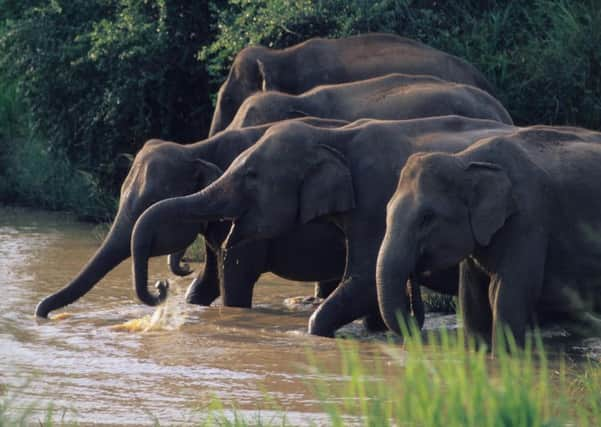Travel review: Sri Lanka


Before the pink sky dawned we were in the Jeep, bumping along dirt pathways through the Udawalawa National Park, camera and binoculars at the ready.
Our driver, an expert spotter, stopped and shut off the engine. His ear was attuned to the distant snorting and trumpeting of elephants. Within moments had a full view of a group of 10 of them, some performing a strange, ungainly dance.
Advertisement
Hide AdAdvertisement
Hide AdThey were covered in mud from their pre-breakfast dip in the river. A little too caked, mum and dad rubbed their bottoms against each other to remove the excess, while the kids tried to get in the way.
We felt privileged to be there, party to the private life of one of Nature’s greatest marvels. Elephants are king here – and they eat relentlessly, as their intestines are only able to absorb a small amount of goodness from each mouthful.
In between elephant sightings, we also spotted water buffalo, deer, land monitors, macaque monkeys and myriad birds including several kinds of eagle, parrots and peacocks during our four-hour safari.
What drew us to Sri Lanka – 11 hours away by plane and basking in temperatures of between 28C and 34C in February, depending on the zone – were reports from friends of its hugely varied and ancient culture, history (Portuguese, Dutch and British colonialism along the way), landscape and wildlife. “India without the hassle and teeming crowds,” they said.
Advertisement
Hide AdAdvertisement
Hide AdThere are crowds in some places, of course. That’s why, after one night at a hotel by the sea, we moved on quickly from the bustle and honking traffic chaos of the capital Colombo.
You can take slow, languorous train journeys around Sri Lanka, but the evolving tourist industry’s mainstay is the host of drivers who, at very reasonable prices, ferry tourists around the island.
We headed inland to Kandy, the centre of Sri Lanka’s cultural triangle of fascinating temples, ruins and land formations. From the decayed grandeur of the Queen’s Hotel, we walked around Kandy Lake, known in Sinhalese as The Sea of Milk.
A spiky monitor lazed on a felled tree trunk, a heron minding its own business nearby. Monkeys swung through the trees. How quickly we got used to their prying eyes and little screeches.
Advertisement
Hide AdAdvertisement
Hide AdNearby the grand Temple of the Tooth, is swarmed three times a day by devout Buddhists queueing with the offerings of jasmine flowers to view for a couple of seconds a casket containing the tooth of Gautama Buddha himself – preserved after his death in 543 BCE.
Maybe it’s to do with the predominance of Buddhism, but the general vibe on the island is serene, laid-back, live-and-let-live. A driver will stop the car to let a mosquito out rather than simply swat it.
After sampling acrobatic Kandyan dancing, eating at the delightful oasis of The Empire Cafe and exploring the tranquil hilltop Udawattekele rainforest sanctuary, we left the city and headed north to the Galkadawala Forest Lodge.
This back-to-nature eco-lodge hosts only up to 10 guests at a time, and we reached our room via a ladder inside a tree house affair. Two sides of the room were open to the forest and its inhabitants – a rattan blind and mosquito net between us and the macaques and chipmunks.
Advertisement
Hide AdAdvertisement
Hide AdThe guests ate together at 7pm, with delicious vegetarian curries and conversation centred around travelling tales against a forest soundscape.
Owner Maulie de Saram talked about the civil war and the 2004 tsunami, which killed 45,000 people and wiped out the homes and livelihoods of many as it tore through the island’s southern coastal towns and villages. All is rebuilt now, there’s been considerable investment, and tourism is booming – bringing more Western ideas of hospitality, for good or ill.
From our forest cocoon, we explored the five glorious ancient cave temples at Dambulla and the restored ruins of the palace and temples at Polonnarua – a 10th century wonder and one-time capital that was later left for the surrounding jungle to devour.
Turning south through rice paddies, we rested briefly at backpacker heaven village Ella, where a hike up Little Adam’s Peak, waterfalls and tea plantation visit are a must.
Advertisement
Hide AdAdvertisement
Hide AdWe ended our 17 days up the coast in the former fortress city of Galle, with its gem dealers, arty shops, cool restaurants and small, eccentric museums. As we ate the last breakfast of fruit platter and daal with hoppers, the plan for our next visit began to emerge…
GETTING THERE
Sheena Hastings flew Manchester- Colombo via Dubai with Emirates, booked via Flight Centre.
Mount Lavinia Hotel, Colombo: mountlaviniahotel.com
Queen’s Hotel, Kandy: queenshotel.lk
Galkadawala Forest Lodge, near Habarana: galkadawala.com
Nil Diya Mankada Safari Lodge, Udawalawa: nildiyamankada.lk
Galle Fort Hotel: galleforthotel.com
What to pack: insect repellent, sunscreen, hat and comfy shoes for the hills; for women, a couple of tops with longish sleeves – modesty is expected when entering temples.